![]()
![]()
![]()
Use LEFT and RIGHT arrow keys to navigate between flashcards;
Use UP and DOWN arrow keys to flip the card;
H to show hint;
A reads text to speech;
42 Cards in this Set
- Front
- Back
|
Describe the basic structure of bone |
Because they contain various types of tissue, bone are organs. Osseous tissue dominates bone, they also contain nervous tissue in their nerves, cartilage in their articular cartilages, fibrous connective tissue lining their cavities and muscle and epithelial tissues in their blood vessels. |
|
|
Describe the basic structure of skeletal muscle |
Each skeletal muscle is a discrete organ, made up of several kinds of tissues. Consists of hundreds to thousands of muscle cells, plus connective tissue wrappings, blood vessels and nerve fibers. Covered externally by the epimysium. |
|
|
Describe the basic structure of connective tissue. |
4 main classes of connective tissue: (1) connective tissue proper(which includes fat and the fibrous tissue of ligaments) (2) Cartilage (3) bone tissue and (4) blood. Connective tissues have 3 main elements: Ground substance, fibers and cells. |
|
|
Scoliosis |
is an abnormal lateral curvature that occurs most often in the thoracic region. More common in females. |
|
|
Kyphosis |
(hunchback) is a dorsally exaggerated thoracic curvature |
|
|
Lordosis |
is an accentuated lumbar curvature. |
|
|
Central Nervous System (CNS) |
consists of the brain and spinal cord, which occupy the dorsal body cavity. The CNS is the integrating and command centre of the nervous system. It interprets sensory input and dictates motor responses based on past experiences, reflexes and current conditions. |
|
|
Peripheral Nervous System (PNS) |
The part of the nervous system outside the CNS, consists mainly of the nerves that extend from he brain and spinal cord. Spinal nerves carry impulses to and from the spinal cord; cranial nerves carry impulses to and from the brain. These peripheral nerves serve as the communication lines that link all parts of the body to the CNS. 2 functional subdivisions : sensory (or afferent) convey impulses to the CNS and motor (or efferent) transmits impulses from the CNS. |
|
|
Sympathetic Nervous System |
Mobilizes body systems during emergency situations |
|
|
Parasympathetic Nervous System |
Conserves energy. Promotes non-emergency function |
|
|
Sensory (Afferent) nerves |
Transmit impulses from sensory receptors in the skin or internal organs toward or into the central nervous system. Located in the sensory ganglia outside the CNS. Except for the bipolar neurons found in some special sense organs, virtually all sensory neurons are unipolar. |
|
|
Motor (Efferent) Nerves |
carry impulses away from the CNS to the effector organs (muscles and glands) of the body periphery. Motor neurons are multi polar, and except for some neurons of the autonomic nervous system, their cell bodies are located in the CNS. |
|
|
Nerve cells (Neurons) |
The structural units of the nervous system. They are highly specialized cells that conduct messages in the form of nerve impulses from one part of the body to another. They have extreme longevity. They are largely amitotic (they lose their ability to divide, except for example, olfactory epithelium and some hippocampal regions). They have an exceptionally high metabolic rate and require continuous and abundant supplies of oxygen and glucose. |
|
|
Neuron cell body (Perikaryon or soma) |
Consists of a transparent, spherical nucleus with a conspicuous nucleolus surrounded by cytoplasm. The cell body ranges in diameter from 5 - 140 µm. The cell body is the focal point for the outgrowth of neuron processes during embryonic development. In most neurons, the plasma membrane of the cell body also acts as part of the receptive surface that receives information from other neurons. |
|
|
Dendrites (of motor neurons) |
Are short, tapering, diffusely branching extension. Typically have hundreds of lacy dendrites clustering close to the cell body. Are the main receptive or input regions. |
|
|
Axon |
Each neuron has a single axon. The initial region of the axon arises from a cone-shaped area of the cell body called the axon hillock and then narrows to form a slender process that is uniform in diameter for the rest of its length. Functionally, the axon is the conducting component of the neuron. It generate nerve impulses and transmits them, typically away from the cell body. |
|
|
Muscle Spindle function |
The muscle spindles provide sensory information about changes in muscle fiber length and tension of muscle fibers. They primarily respond to any stretch of a muscle, and through reflex response, initiate a stronger muscle action to reduce this stretch. |
|
|
Muscle Spindle structure |
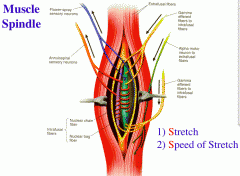
|
|
|
Golgi Tendon Organ function |
connects to up to 25 extrafusal fibers near the tendon's junction to eh muscle. These sensory receptors detect differences in the tension generate by active muscle rather than muscle length. When simulated by excessive tension, the Golgi receptors conduct their signals rapidly into the spinal cord t elicit reflex inhibition of the muscles they supply. They function as a protective sensory mechanism. Ultimately, the GTOs protect the muscle and its connective tissue harness from injury from excessive load. |
|
|
Golgi Tendon Structure |
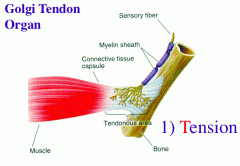
|
|
|
Endocrine system |
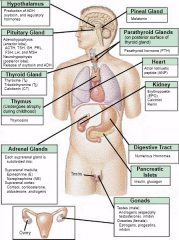
Helps to integrate and regulate bodily functions and thus provides stability to the internal environment. Hormones produced by the endocrine glands affect almost all aspects of human function. |
|
|
Growth Hormones |
Released by anterior pituitary gland. Stimulates tissue growth; mobilizes fatty acids for energy; inhibits CHO metabolism. Increased hormone secretion with increasing exercise. |
|
|
Testosterone |
Released by testes. Controls muscle size; increases RBC; decreases body fat; promotes male sex characteristics. Increased hormone secretion with exercise. |
|
|
Estrogen |
Released by ovaries. Controls menstrual cycle; increased fat deposition; promotes female sex characteristics. Increased hormone secretion with exercise; depends on menstrual phase. |
|
|
Insulin |
Released by pancreas. Promotes CHO transport into cells; increases CHO catabolism and decreases blood glucose; promotes fatty acid and amino acid transport into cells. Decreased hormone secretion with increasing exercise. |
|
|
Glucagon |
Released by pancreas. Promotes liver's release of glucose to blood; increases lipid metabolism, reduces amino acid levels. Increased hormone secretion with increasing exercise. |
|
|
Cortisol |
Released by the Adrenal cortex. Promotes fatty acid and protein catabolism; conserves blood sugar/insulin antagonist; has anti-inflammatory effects with epinephrine. Increased hormone secretion only in heavy exercise. |
|
|
Catecholamines (epinephrine and norepinephrine are collectively called catecholamines) |
Released by Adrenal medulla. Facilitate sympathetic activity, increases cardiac output, regulates blood vessels, increases glycogen catabolism and fatty acid release. Increased epinephrine secretion in heavy exercise, increased norepinephrine with increasing exercise. |
|
|
Digestive system |
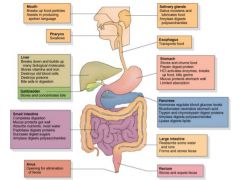
The alimentary canal (GI tract) is the continuous, muscular digestive tube that winds through the body. It digests food- breaks it down into smaller fragments (digest-dissolved) and absorbs the digested fragments through its lining into the blood. The organs of the GI tract are the mouth, pharynx, esophagus, stomach, small intestine and large intestine. |
|
|
Breakdown of macronutrients |
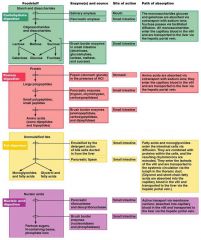
|
|
|
Interrelationship between centre of gravity, base of support, balance and stability |
high stability (low mobility) is characterized by a large base of support, a low center of gravity, a centralized center of gravity projection within the base of support, a large body mass, and high friction at the ground interface. Low stability (high mobility), in contrast, occurs with a small base of support, a high center of gravity, a center of gravity projection near the edge of the base of support, a small body mass, and low friction. |
|
|
Low back pain |
Muscular weakness, particularly in the abdominal and lower lumbar back regions, lumbar spine stability and poor joint flexibility in the back and legs represent primary external factors related to low back pain syndrome. Prevention of, and rehabilitation from, chronic low back strain commonly use muscle-strengthening and joint flexibility exercises. |
|
|
Biomechanics |
Sport and Exercise Biomechanics is a title that encompasses the area of science concerned with the analysis of mechanics of human movement. In other words it is the science of explaining how and why the human body moves in the way that it does. In sport and exercise that definition is often extended to also consider the interaction between the performer and his or her equipment and environment. Biomechanics is traditionally divided into the areas of kinetics (concerning the analysis of the forces acting on the body) and kinematics (concerning the analysis of the movements of the body) |
|
|
Ergonomics |
The science of making things fit people. Ergonomics uses knowledge from the fields of anatomy, mechanics, physiology, and psychology to utilize human energy most effectively. Something that is ergonomic is designed for safe, comfortable, and efficient use. |
|
|
Kinesiology |
examines physical movement and its effects on "health, society and quality of life." |
|
|
Concentric |
concentric muscle actions occur when muscles shorten under tension, leading to changes in joint position. |
|
|
Eccentric |
eccentric muscle actions occur when muscles lengthen under tension, leading to changes in joint position. |
|
|
Isometric |
isometric muscle actions occur when no movement in the joint take place. The muscle does shorten and the tendon does lengthen but this does not alter joint position. |
|
|
Variable Resistance |
variable externalresistance is a form of external resistance that changesthroughout the movement. This can be achieved in practice using bands andchains in combination with barbells or by using machine weights with camdevices |
|
|
Isokinetic Resistance |
isokineticexternal resistance is a form of variable resistance that maintainsthe velocity of the movement constant irrespective of the force applied. It isonly achievable in practice using a dynamometer. |
|
|
Accommodating resistance |
strictly,accommodating resistance is the same as isokinetic resistance, where the load“accommodates” the force applied by the subject so that velocity remainsconstant throughout the movement. In practice, the term “accommodatingresistance” is often used to refer to bands and chains, which are a form ofvariable resistance that approximate isokinetic external resistance. |
|
|
Plyometric |
plyometricexercises take advantage of the stretch-shortening cycle (SSC) whereby amuscle rapidly lengthens and then explosively reverses its action. |

